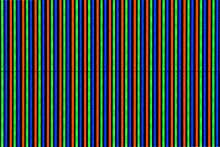
Aperture grille
An aperture grille (tension mask) is one of two major technologies used to manufacture color cathode ray tube (CRT) televisions and computer displays; the other is shadow mask.
Fine vertical wires behind the front glass of the display screen separate the different colors of phosphors into strips. These wires are positioned such that an electron beam from one of three guns at the rear of the tube is only able to strike phosphors of the appropriate color. That is, the blue electron gun will strike blue phosphors, but will find a wire blocks the path to red and green phosphors.
The fine wires allow for a finer dot pitch as they can be spaced much closer together than the perforations of a shadow mask, and there need be no gap between adjacent horizontal pixels.
During the display of bright images, a shadow mask warms, and expands outward in all directions (sometimes called blooming). Aperture grilles do not exhibit this behavior; when the wires heat up, they expand vertically. Because there are no defined holes, this expansion does not affect the image, and the wires do not move horizontally.
Podcasts:

